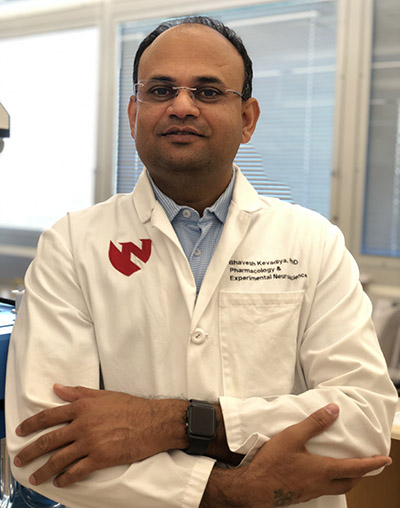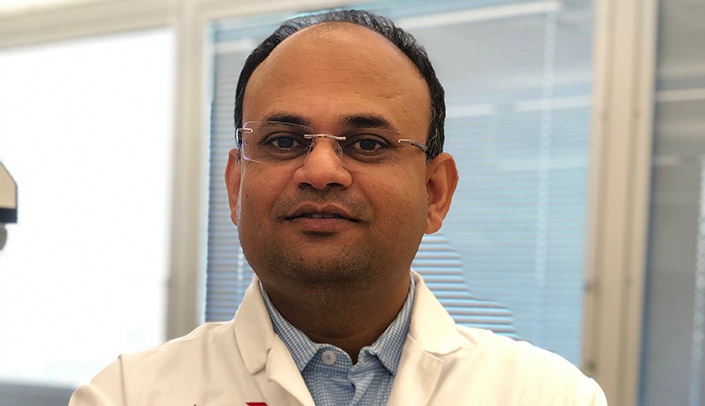 |
Bhavesh Kevadiya, PhD |
Bhavesh Kevadiya, PhD, began working in molecular imaging as a postdoc at UNMC. But after a sabbatical at Stanford University — recognized as having the best molecular imaging program in the world for cancer diagnostics and therapy (theranostics) — he returned to Nebraska as an assistant professor. Here in Omaha, Nebraska, he is creating a world-class viral theranostics program.
“At Stanford, they focus on cancer,” Dr. Kevadiya said. “But I wanted to bring this technology to virus molecular imaging, particularly HIV-1 and SARS-COV-2.”
The creation of a lab that will use molecular imaging and therapeutic payload tracking to target infectious diseases will put UNMC on a path toward groundbreaking translational research. It will impact early diagnostics and treatment of infectious disease. The technologies being developed could be used throughout the world.
Molecular imaging is being used in real-time, Dr. Kevadiya said, to explore interactions between the microbe and the body’s subcellular, cell and tissue pathologies. It permits tracking between a virus and the drugs or the immune system fighting it and allows researchers to discover if treatment is arriving where a virus is present in the tissue so it can be eliminated.
Illustrating science
Dr. Kevadiya also is a skilled scientific illustrator.
He recently got to use his artistic talents when he worked with Dr.Gendelman and other collaborators on a major COVID-19 paper submitted to Nature Materials and an invited review in the Journal of Neuroimmune Pharmacology.
Dr. Kevadiya did all the illustrations for the articles, including key images documenting the SARS-COV2 lifecycle and a comparison of a healthy and injured alveolus in a COVID-19 patient.
Dr. Kevadiya said that he’s not a trained illustrator, but, evolving from his hobbies of painting and drawing, he’s become adept at using illustrating software to more easily communicate difficult scientific concepts.
“They say there’s a thousand words in one picture, right?” he said.
“Using molecular imaging to address infectious diseases, particularly in relation to CRISPR-Cas9 technology for the treatment of diseases, is an exciting avenue of research with potentially global implications to eliminate chronic infections,” Dr. Kevadiya said.
Consider a person who has had HIV. Using molecular imaging, researchers can radiolabel the nanoparticles of a long-acting antiretroviral and gene-editing technology therapy and track the real-time path of the particles in a living person — checking the effectiveness of the targeting at different time intervals.
So rather than waiting years to see how a particular dosage or toxicity of the drug is affecting the virus (while the drug also is affecting the patient), the researcher can track the levels of the virus and see how much of a drug is needed to improve the therapeutic outcomes in a much shorter time.
The results, Dr. Kevadiya said, could lead to more effective therapies for infectious diseases beyond HIV or SARS-CoV-2, the virus that causes COVID-19.
Dr. Kevadiya, a mentee of UNMC’s Howard Gendelman, MD, also is training other members of the UNMC research community in molecular imaging “theranostics” — he will have at least six researchers working with him as he begins to build his program.
Dr. Gendelman calls Dr. Kevadiya and his team “an unstoppable combination of intellect, hard work and fortitude,” in part because of Dr. Kevadiya’s commitment not just as a researcher, but as a mentor.
“Indeed, while he was away from the laboratory working at Stanford University, he continued to support fellows, technicians and students with talks, experimental insights, interpretations of data and even writing papers and grants,” Dr. Gendelman said.
Dr. Kevadiya said the new lab, which already is generating grants, is an excellent opportunity for UNMC to increase its reputation as a world leader in the fight against infectious diseases.
“Now, during a pandemic, everyone sees how important this work is,” he said. “It will be a challenge, but let’s see how we can try to make a better future for everyone in the face of infectious diseases.”

Great people are rarely available, it's your LUCK to have Dr. Bhavesh Kevaliya ….. congrats to all associated.
Very very good
Great work by Dr.Kevadiya sir
Welcome back, Bhavesh. Hope to see you soon in the EMCF. Tom Bargar
Congratulations Dr.Kevadiya
Congrats Dr. Kevadiya! -YH